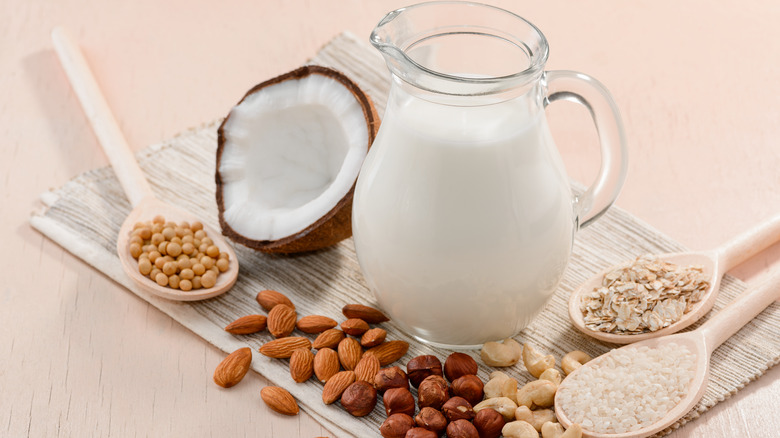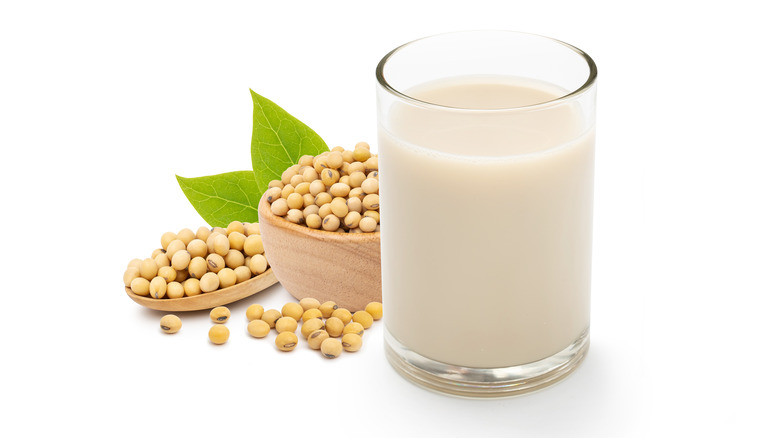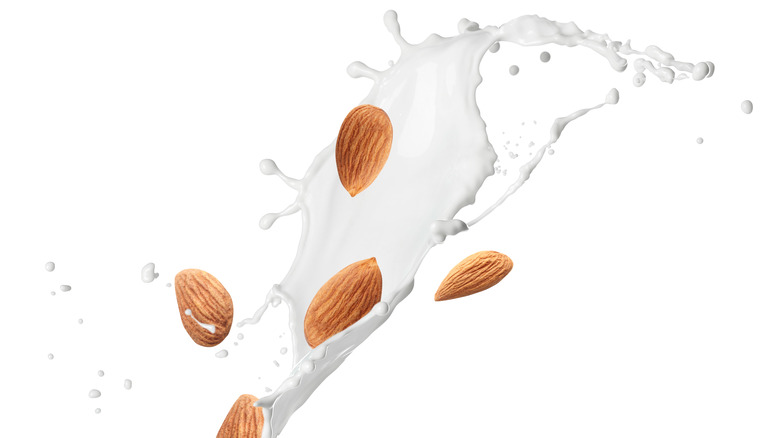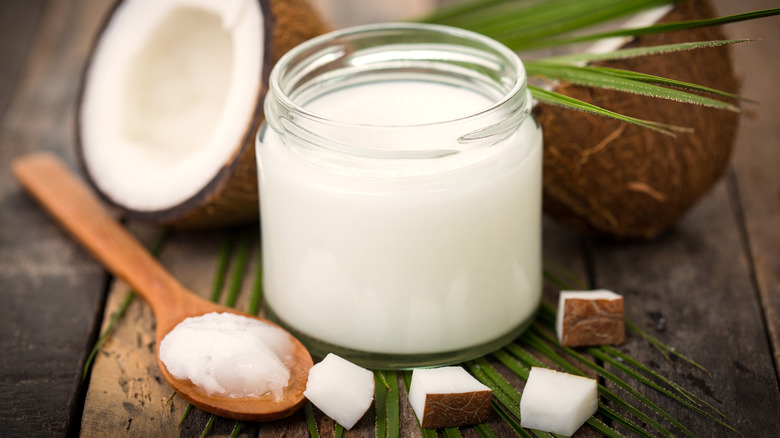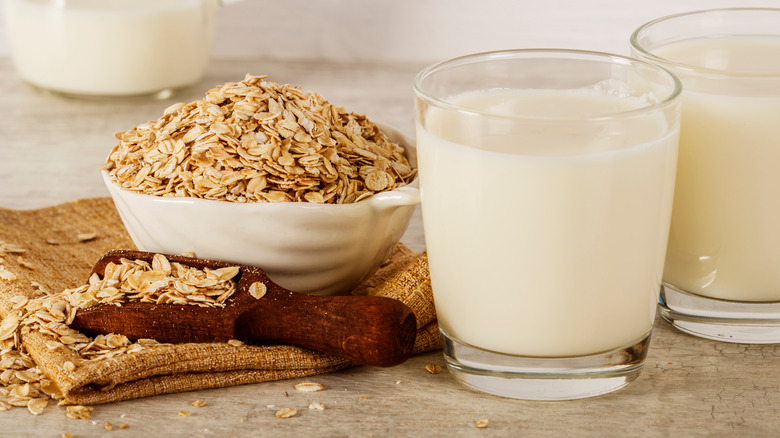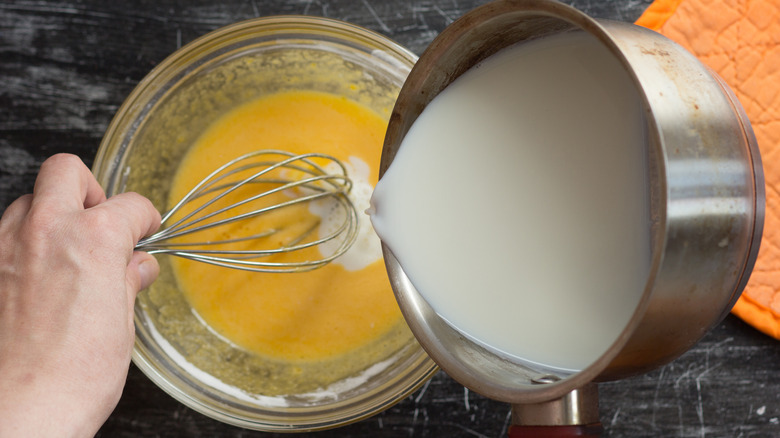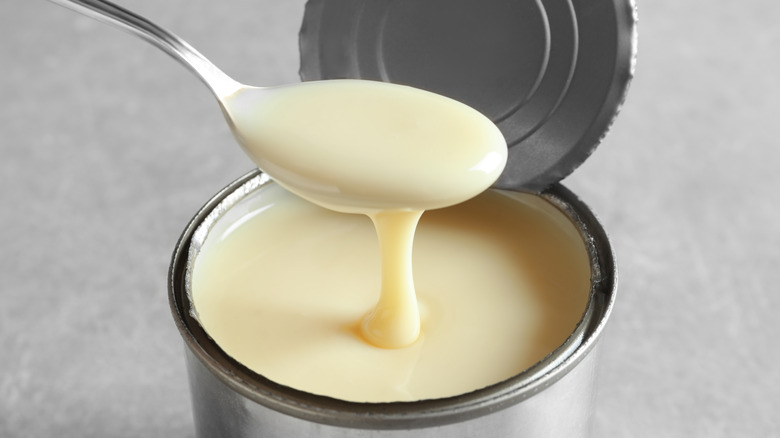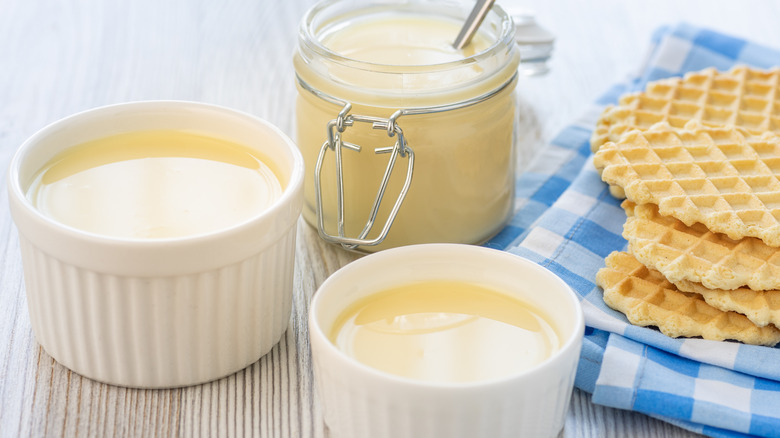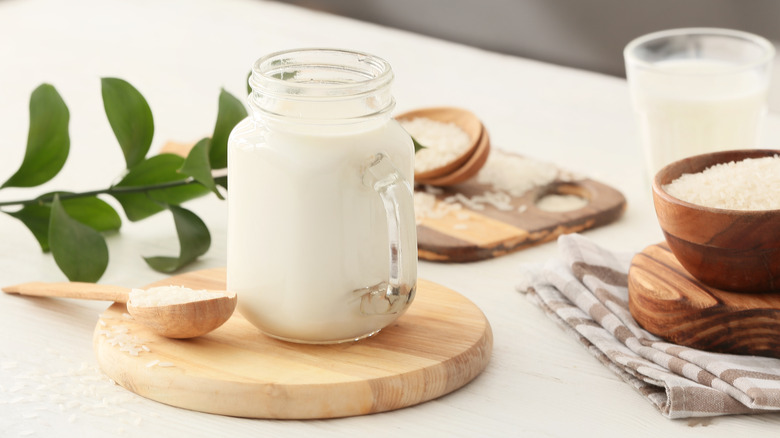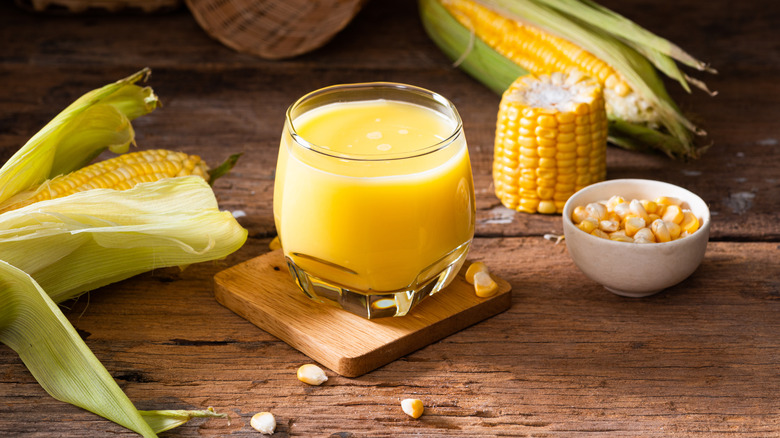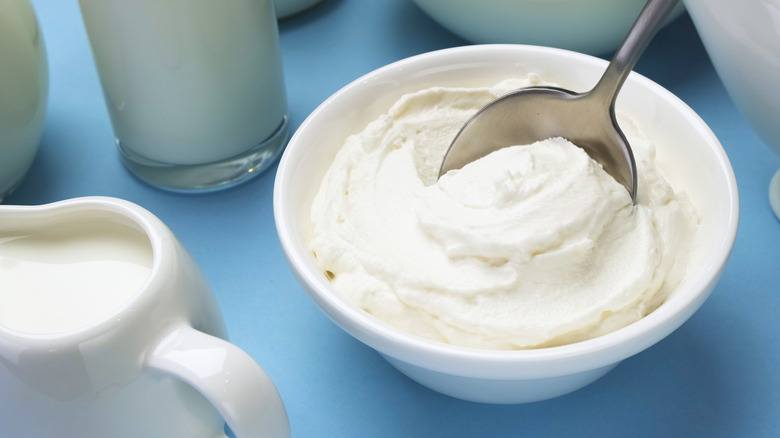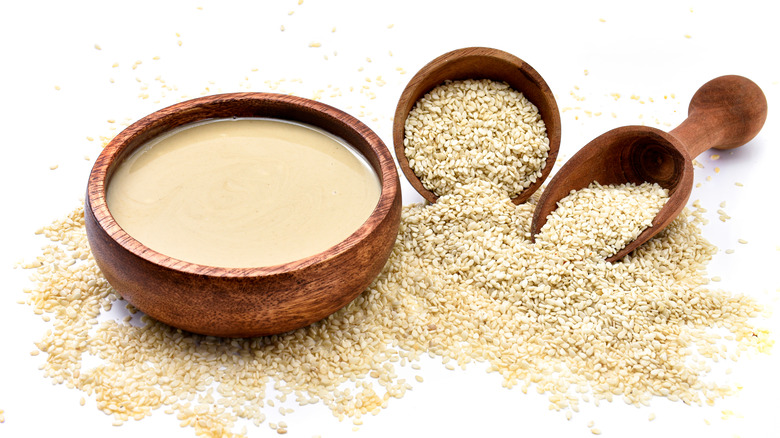The Absolute Best Milk Substitute For Cooking
We may receive a commission on purchases made from links.
It's dinner time, and you're craving something creamy, rich, and indulgent. But, for various reasons like lactose intolerance or dietary choices, the inclusion of cow's milk in your diet is not an option. Or, maybe you're looking for dairy in a different form. Nutrient-dense, Healthline writes that cow's milk provides essential vitamins, minerals, and protein that strengthen muscles and improve heart health, immune system, and bone density. However, milk's positive aspects are often overshadowed by the negative, including that 30 to 50 million Americans have milk allergies or lactose intolerance, per the Office of Women's Health.
Luckily, store shelves are lined with alternative options to choose from when looking for a delicious substitute for traditional cow's milk, including the growing category of uber-nutritious, plant-based selections. The Good Food Institute reported that over 754 million units of plant-based milk were sold in 2020, accounting for 15% of sales in the overall milk category. The key for any milk substitute is to find one with the most similar taste, texture, and consistency to regular milk. Thus, ensuring your sauces, soups, casseroles, and baked goods taste the way you expect them to. Plant-based milk substitutes, along with various alternative options, will swap out seamlessly when cooking and add an unexpected, delightful flavor.
Soy Milk
Soy milk is the grandfather of non-dairy milk alternatives, with some chronologies placing the creation of the first soy milk in China during the second century B.C., as noted by the Soy Info Center. Accordingly, tofu came along at the same time. Low in fat, zero cholesterol, and with relatively little taste, Food Network believes soy milk is the best alternative for milk when baking. Its high protein content gives structure and density to baked items while helping them brown evenly. The texture and consistency are similar to regular cow's milk, making soy milk an easy one-to-one swap.
Epicurious offers make-at-home soy milk begins with soaking raw soybeans overnight, then grinding them down to a fine powder, cooking with boiling water, and straining. But, there are dozens of flavored and unflavored options available for purchase without the kitchen mess. Cooking with soy milk today has vastly improved from a few decades ago. Today's pre-packaged options lack the inherent "beany" flavor akin to the drink years ago. The Soy Info Center shares that in the 1970s, researchers began to improve soy milk's taste by removing its chalky, ashy, earth aftertaste with modifications. This action ensures the cartons you buy off the shelf will have a more neutral taste similar to cow's milk enhancing anything from mashed potatoes to cinnamon rolls.
Almond Milk
According to the Plant Based Food Association, plant-based milk in the United States is a $2.5 billion industry, with almond milk being the most popular alternative, accounting for ⅔ of the total plant-based milk category sales. Almond milk has a slightly nutty flavor and creamy texture, albeit thinner than other plant-based milk. Greenmatters offers the process of making almond milk like many other nut milk options; almonds are soaked overnight and then combined with water and blended. For almonds, the ratio is 1 cup of almonds to 2 cups of water. For other nuts, like cashews, the proportion is 1 cup of nuts to 3 cups of water. Blend until smooth, strain through a fine-mesh sieve, and enjoy.
But, how does one cook with almond milk? With its silken texture and consistency, almond milk has a one-to-one swap for regular dairy milk, according to Greenmatters, making it an easy alternative for any sweet or savory recipe that calls for the use of milk. A few tips, though; It is best to avoid boiling almond milk, as overheating may give a bitter taste. When cooking with almond milk, you may need to reduce the amount of sweetener recommended in a recipe as pre-packaged almond milk often contains loads of sugar. Almond milk can be the star to jazz up your Sunday brunch, capable of lifting overnight steel-cut oats, making a vegetarian mushroom meatloaf, or decadent vegan chocolate cupcakes.
Coconut Milk
When cooking savory or sweet dishes, turn to coconut milk instead of cow's milk to cool off spicy dishes like Thai chicken curry or Tom Kha soup. Coconut milk can also enrich your favorite sweet treats like cupcakes, pie, and ice cream. This milk substitute is made by blending the flesh of a mature coconut with hot water to create a creamy liquid (via MasterClass). The resulting milk has a nutty, floral taste of the tropics and is available in cartons next to the almond and soy milk or cans down the Asian food aisle of grocery stores everywhere. Both forms can be used instead of milk when cooking, with an easy one-to-one swap per Livestrong. Whichever your preference, keep in mind that coconut milk separates into two parts.
Eater explains that a semi-solid, full-fat cream rises to the top with a more watery liquid underneath. The cream is the richest, fattiest portion of coconut milk. Shaking the can before opening will blend the two, usually to the desired consistency for savory dishes or baking. It is always best to start with unsweetened coconut milk to control the sugar in your recipe. Cook's Illustrated writes that coconut cream is a perfect swap for heavy cream. And a can of coconut milk will generally cost you less than $3 at your local Target compared to heavy cream, which can cost upwards of $11 for a 16 ounce carton, per The Pricer.
Oat Milk
Healthline writes that oats are a nutritional flavor bomb packed with protein, vitamins, minerals, and fiber. It's likely why we see people of all ages eating heart-healthy Cheerios, one of the most nutritious breakfast cereals available, as per Livestrong. The benefits of this foodstuff derive from oats, which may help lower blood pressure and cholesterol. Reporting by the BBC suggests oat milk is one of the most eco-friendly milk alternatives, using less water and land and emitting less carbon than soy, rice, or dairy milk. Oat milk has a creamy, milk-like taste and texture with a subtle earthy grain flavor. Where dairy milk can have a mineral saltiness, oat milk is naturally sweet.
When baking, follow the recipe instructions for cow's milk using oat milk with a one-to-one swap. The two have similar textures and consistency, says Martha Stewart, with the alternative milk giving a toasty accent to freshly baked bread, muffins, or pastries. You can also easily swap oat milk for cow's milk to provide body in soup or chowder. However, if you are looking for a swap for heavy cream — possibly to make custard or whipped cream — opt for evaporated milk or coconut milk instead. As Martha Stewart advises, oat milk will often cause a dish not to cook the way you intend and can fail to set in flan or mousse.
Lactose-Free Milk
Yes, lactose-free milk is still made from cow's milk, but with the lactose removed, thus solving the worldwide intolerance issue faced by 68% of the global population (as reported by the Cleveland Clinic). Lactose-free milk is the same protein-packed, nutrient-dense option as real cow's milk with an identical texture, consistency, and close flavor (via Healthline). However, lactose-free milk has the addition of the enzyme lactase, which is not produced naturally by people who are intolerant to dairy. When added to milk, lactase breaks down lactose, making cow's milk easier to digest.
The main difference between the two kinds of milk is that lactose-free milk has higher simple sugars, which makes it easier to digest than traditional cow's milk, but also makes the lactose-free milk taste sweeter on the palate. When cooking or baking, The Dairy Alliance notes you are free to use it in the same proportions as any cow's milk, and because of this perceived sweetness, lactose-free is a good go-to milk substitute for sweet breakfast items and desserts.
Evaporated Milk
Evaporated milk is a thick, concentrated substance produced by heating cow's milk until the overall water content reduces by over 50% (via Healthline). The cream-white liquid has a subtle caramelized flavor due to the high-heat cooking method. Silky and rich, evaporated milk is available in 5 ounce or 12 ounce cans that are pantry-shelf-stable for one year, ensuring you never have to run to the store when you forget that your cornbread recipe requires something extra. For savory or sweet cooking, if fresh milk isn't on hand, make sure you've stocked up on cans of evaporated milk.
When using in place of fresh milk, reconstitute evaporated milk to the consistency of regular milk by adding equal parts of water. Culinary Lore shares that one cup of whole milk is equivalent to ½ cup of evaporated milk and ½ cup of water, easily swapping out one-to-one with regular milk. But, using it straight from the can is also perfect, especially if you have a craving for velvety, dreamy mac and cheese, as the product will meld harmoniously with cheese and noodles without separating or curdling when heated.
Sweetened Condensed Milk
Condensed milk is the sweeter sister of evaporated milk, and don't get them confused when cooking savory, or you could end up with some highly saccharine sauces. Marrying whole milk with sugar — a lot of sugar — condensed milk is perfect for making indulgent sweet treats but won't serve cooking purposes outside of that. Food Network notes that the condensed milk process starts like evaporated milk; whole milk is cooked down to remove the water, but condensed milk includes over 6 ounces of added sugar per 14 ounce can. The result is creamy, syrupy, low-moisture milk goodness with a rich, caramelized flavor that is also pantry-shelf-stable.
A dessert in itself, condensed milk can be heated in the can to create decadent Dulce de Leche. It is also a key ingredient in Tres Leches cake and key lime pie and can make your Rice Krispies treats unctuously divine. You can also use heavy cream to create a quick and easy ice cream with condensed milk, per the Kitchn. Fortunately, you won't need an ice cream maker or the prep-time, a swap we will gladly enjoy. Condensed milk even plays a key ingredient in various popular types of coffee, like cà phê sữa đá.
Rice Milk
Rice milk continues to be one of the leaders in the plant-based milk category, per The Healthy, which notes that for those who suffer from food allergies, rice milk may be the best alternative milk to include in your diet. Produced by pressing softened rice through a grinder and then combining it with water and straining, rice milk is often fortified with added calcium and vitamins as it inherently lacks the nutritional value provided by cow's milk. It is, however, very high in carbohydrates which can be good if you need a quick energy boost.
Award-winning chef and author, David Lebovitz, notes that rice milk can be swapped for whole milk one-to-one, sharing recipes for soup, rice pudding, and ice cream. Adding rice milk (versus some other plant-based options) is best for ice cream as the neutral dairy milk-like taste will allow whatever flavor of ice cream you are making to shine. The texture of rice milk is thinner than regular cow's milk and has less protein, so if you are making pudding or custard, you will need to increase the thickening agent you are using, like cornstarch or tapioca, per Goodbaker.
Corn Milk
As we head into a summer season blooming with fresh corn recipes, think twice before throwing your corn stalks away, as they contain liquid gold. Produced by literally milking cobs, corn milk is a go-to substitution used to enrich soups, stews, or casseroles with natural sweetness (via America's Test Kitchen). Capturing corn milk starts with a whole corn cob husked and the kernels removed. For the most flavorful corn milk, it is best to use fresh, in-season corn, per bon appétit. The naked cob is then "milked" using the back of a knife or box grater to remove the liquid.
This silky and starchy liquid will give richness to soup or chowder, thickening the broth without milk or cream, notes the Huffington Post. Consider that corn starch is used as a thickener in soups, whisked with water to create a slurry before adding to dishes. Corn milk is like that, giving texture and viscosity to a dish. Consider using it instead of milk to create luscious cream-free creamed corn. Unfortunately, corn milk is not a convenient solution as it is not widely available commercially.
Velouté
What do you do if you need to thicken a sauce or soup to give it the texture and consistency of cream, but you prefer not to include any sort of milk ingredient, animal or plant-based? The French have you covered with the classic velouté sauce. One of the five "mother sauces" of the country, Healthline explains that velouté is similar to a bechamel sauce though bechamel uses milk and velouté uses stock. Meaning "velvety" in French, and sounding much fancier than it is, making velouté is rather easy. Rouxbe shares that to make the sauce begin by adding flour and butter to a saucepan over medium heat and whisk constantly to make a roux. Then slowly pour in the stock of your choice, whisking until the sauce thickens and you have a delicate mixture for use on fish, chicken, or vegetables. Voilà, velouté.
Chicken stock is the most common ingredient, but you could also use bone broth, adding in the nutrition benefits of collagen-rich ingredients that may help improve skin tone and bone density. Like all five mother sauces, the downy velouté is the base to create other classic sauces (via Masterclass). Add lemon, parsley, and shallot with fish velouté to create Bercy sauce for poached or seared seafood. Or, showcase baked chicken and roasted vegetables with a Poulette sauce made with velouté, mushrooms, parsley, and lemon. You could also use a straight velouté sauce as a substitute for bechamel in baked mac and cheese, per eHow, or as the base in Martha Stewart's Turkey Tetrazzini.
Greek Yogurt
The staple of many morning meals, Greek yogurt is "strained" yogurt, or regular yogurt with the liquid, or whey, removed, per bon appétit. Straining yogurt is a common practice in Greece and many Middle Eastern countries, and the popularity of this process has grown exponentially in the U.S. over the past few years. ABC News reports that Greek yogurt controlled just 1% of the yogurt market in 2007, rising to capture over 40% just six years later. If you are looking for an alternative to high-fat dairy options like whole milk or heavy cream, tangy, concentrated, and creamy Greek yogurt should be your go-to.
Undeniably Dairy shares that yogurt's natural acidity gives a dish a slightly more zinging flavor when used instead of milk. The high-fat content of full Greek yogurt makes it a good swap one-to-one for heavy cream, perfect to use to thicken sauces and add richness, body, and tang to your meal. It should be added at the very end of a recipe, otherwise, the heat will make the milk solids separate and curdle (via the Chicago Tribune). As Greek yogurt can be dense, whisking some water into the yogurt gives it a more milk-like consistency (closer to plain yogurt), which is better for baking, per Epicurious. Greek yogurt is also a high-protein swap for mayonnaise, butter, or sour cream.
Tahini
If you are like us, you may have a jar of tahini paste in the back of your pantry purchased several months ago to eventually use in homemade hummus. As the pasty nut butter made from ground sesame seeds, tahini is an essential ingredient in the dip. You will be happy to have it on hand because nutty, toasty, savory tahini is an easy swap for milk and cream (via Real Simple). It is packed with nutrients and healthy fats, and you can make tahini milk by stirring ¼ cup of tahini into 3 cups of water. Use tahini instead of milk or heavy cream to add depth to sauces and creaminess to soup, per bon appétit. Just a tablespoon or two will drastically enrich your dish. Or use it in substitution of dairy in dressings.
Since tahini has zero sugar, unlike many nut butter options, you can control the sugar in your recipe. A significant element about tahini versus other nut or seed butter is that it doesn't have an overwhelming nutty flavor, so it won't overpower the dish it is being added to. Instead, it gives a subtle earthiness. And, don't be afraid to use it in sweet dishes as well. Tahini is a natural stand-in for dairy butter, especially in chocolate chip cookies.
Goat Milk
Though Americans most commonly drink milk produced from a cow, internationally, goat milk is the most widely consumed dairy, per WebMD. Milk from goats has lower levels of lactose and a higher amount of protein. Flavorwise, goat milk will have a slightly tangier, mineral taste than cow milk and is ideal for use in savory and sweet dishes, adding depth, zestiness, and texture. Hello Homestead shares that goat milk has a creamy richness thanks to its high butterfat content, and though you can swap it one-to-one for cow's milk, the resulting dish may be more unctuous.
Most commonly used to make cheese, goat milk finds its way into everything from custard to ice cream, butter to yogurt, per the American Dairy Goat Association. Another benefit of the foodstuff is that goat milk is naturally emulsified, like cream and milk, ensuring it will not break apart when cooked with heat. The ADGA adds that goat milk has higher levels of Vitamins A and B and prominent levels of essential minerals as well.
